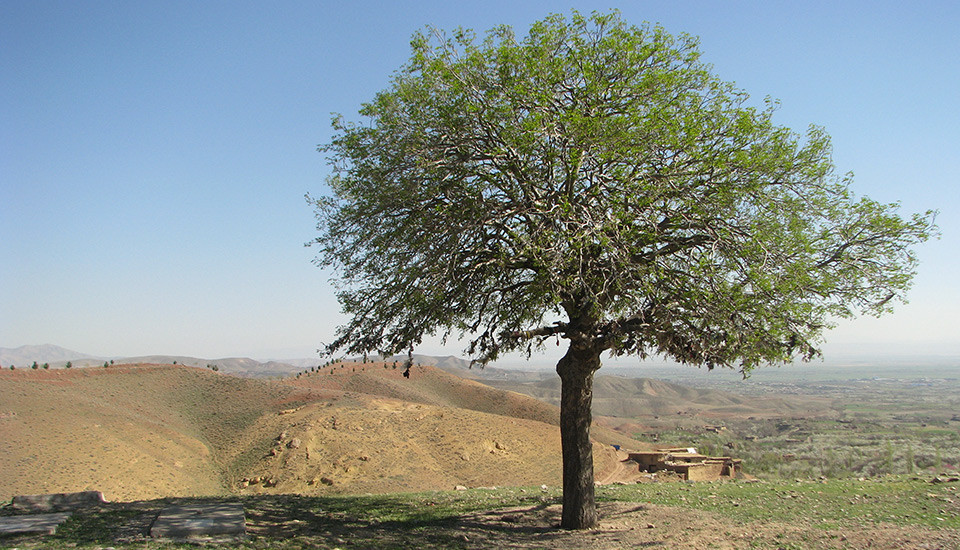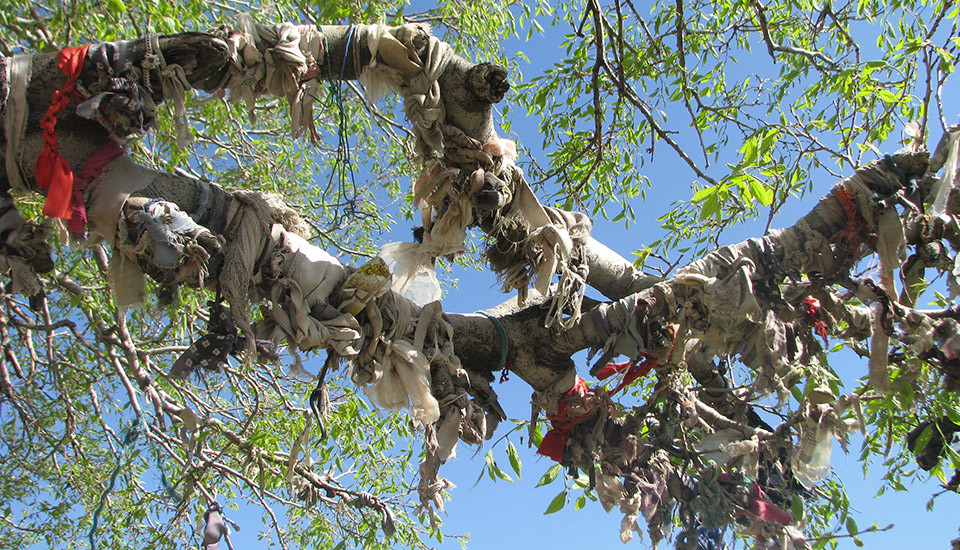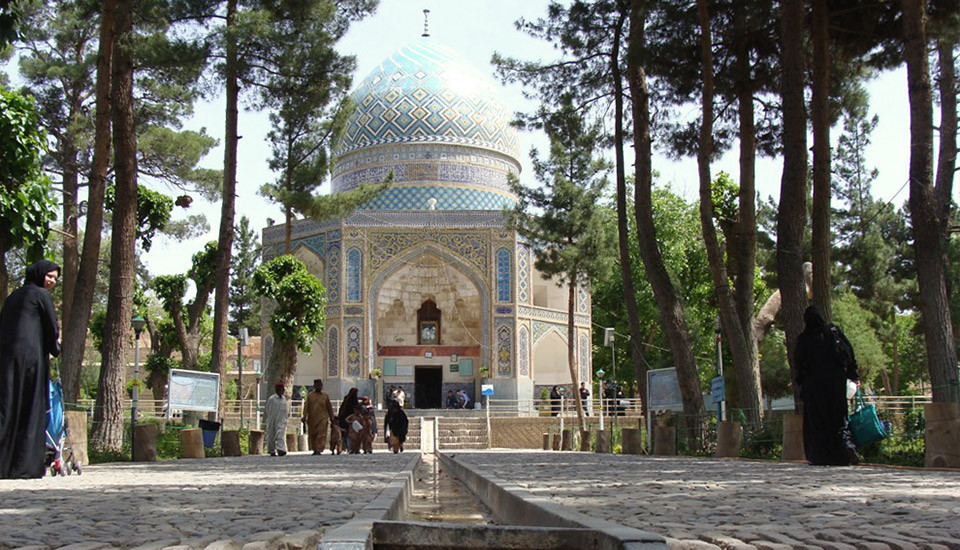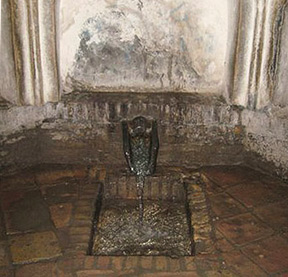Neyshābūr гэта горад на паўночным усходзе Ірана. Вялікая яго частка знаходзіцца ў шырокай раўніне, акружанай пагоркамі і гарамі. Існуюць розныя святых прыродных аб'ектаў у пасёлку, ад святыя дрэвы і святыя крыніцы ў святы валун і святыя сады. Плошча дамоў некалькі эндэмічных відаў раслін і жывёл. It also contains protected areas and ecotourist destinations such as waterfalls, спружыны, Рэкі і вока лоўлі геаграфічныя асаблівасці, як горныя вяршыні. The climate is semi arid to dry with an average annual rainfall of 300 mm.
In spite of the fact that these sites are protected by local communities, their future is threatened by urbanisation, population growth, infrastructure development and tourism.
Абаронены
Захавальнікі
Мясцовыя жыхары паважаюць прыродныя асаблівасці, паколькі яны маюць карані ў іх рэлігійных перакананняў. Qadamgah ў Neyshābūr напрыклад,, з'яўляецца фарсі сад, дзе прырода была прасякнута духоўных каштоўнасцей. Ён змяшчае асабняк, дрэвы, басейны і патокі. Адна са сцен асабняка ўтрымлівае чорны камень, на якім два сляды былі выразаныя. Людзі лічаць, што гэтыя адбіткі належаць да 8 імама шыітаў, мужчынскі духоўны лідэр лічыцца нашчадкам Мухамеда, чароўна прызначаны для кіраўніцтва людзей. Слова Qadamgah азначае след і ставіцца да гэтага апавядання.
Qadamgah’s history as a sacred site dates back to the pre-Islamic period. Though its original purpose is unknown, it is historically linked to the Sassanid prince Shahpour Kasra, as well as to Imam Ali and Imam Reza. Word goes that in 921 AD Imam Reza stopped at the garden on his way from Medina to Marv. The instant he wanted to perform his ablutions, a spring welled out of the earth. The spring has been regarded sacred ever since and people believe this water has healing properties.
Some plane trees (Plantanus sp.) have been actively conserved for centuries. Plane trees in Iran have been regarded as sacred for a long time because of the shade they offer, their largeness and their green appearance. All over Iran some plane trees have been kept alive for centuries. Legends and beliefs about some specimens have caused people to stay away from them. A long lived plane tree in a village of Neyshabur, напрыклад, is conserved by local people because they believe that a man once lost his family due to the breaking of its branches.
Local people still conserve lesser-known sacred sites which have no legal protection. Значэнні такіх сайтах вучаць маладое пакаленне і рэлігійных цырымоній і практык ажыццяўляецца супольна, як гэта было на працягу стагоддзяў. Такім чынам,, Наступнае пакаленне вучыцца, каб абараніць іх.
Хоць ёсць афіцыйная стратэгія кіравання, people tend to protect their sites. Some implement short term measures at a local level. Among a wide variety of plans that are carried out for example, a park has been established around a wish tree and tourist services have been developed there.
Дзеянне
Local people and religious institutions continue their age-old practices. The local offices of Cultural Heritage, Handicrafts and Tourism register long-lived trees as national natural monuments. National natural monuments are relatively small, interesting, unique, exceptional, unconventional and irreplaceable phenomena of plant and animal collections having scientific, historical or natural significance. Protective measures in these areas guarantee their sustainable non-commercial use.
There is also a national plan for inventory and conservation of long lived trees under supervision of the Лясы, Range and Watershed Management Organization of Iran. Recent research by Maryam Kabiri draws the attention to the significance of the spiritual values that these and other sacred sites have in relation to nature conservation.
Палітыкі і правы
У заканадаўстве Ірана няма згадкі святых прыродных аб'ектаў да гэтага часу. Некаторыя святых прыродных аб'ектаў былі афіцыйна захоўваецца, таму што яны знаходзяцца ў ахоўных раёнах або ў нацыянальны помнік. Іншыя былі адмыслова зарэгістраваныя ў якасці нацыянальных прыродных помнікаў. Культурнай спадчыны і дэпартамента навакольнага асяроддзя ўлады маюць права голасу ў абарону нацыянальных прыродных помнікаў. Яны выступаюць у асноўным для рэдкіх відаў флоры і фауны і выдатныя утварэнняў зямлю, пейзажы або нават векавыя дрэвы. Затым яны ўзятыя пад абарону шляхам прызначэння падыходнага па перыметры.
Кааліцыя
Some sacred sites in the area are under supervision of Endowments and Charity organizations (responsible for endowments and sacred places such as mosques and shrines) and a trustee board of local people. The Cultural Heritage, Handicrafts and Tourism Organization is responsible for registration and management of historical monuments and national natural monuments.
Qadamgah, напрыклад, has been registered in this way, but it is also under supervision of endowments and charity organization of Iran and of the local trustee board. As in the case of Qadamgah, when a site has both cultural and spiritual values these organisations cooperate in the conservation and management of the site.
Захаванне інструменты
Criteria for conservation have been set up and these criteria have led to maps of areas in the township of Neyshabur which are in need of prioritized conservation. Some recommendations have additionally been formulated in this thesis, which may help with the initial steps for planning political agenda and developing criteria and indices of a national natural monument such that takes spiritual values into account.
Вынікі
Sacred natural sites as a part of bio cultural diversity have been protected for centuries by local beliefs and values. Nowadays these sites are threatened for different reasons. If they are to survive, бягучыя меры павінны быць падмацаваныя прававой абароны. Для гэтай мэты, выкарыстоўваючы комплексны падыход, заснаваны на сумесным крытэрыяў і палітыкі ў галіне прыроды і культуры можа згуляць ключавую ролю ў захаванні святых прыродных аб'ектаў. Кабірыя хэнд (2011) вызначаны такія крытэры для захавання святых прыродных аб'ектаў у пасёлку Neyshābūr.
- Bahar, M. (1995) From myth to history. Cheshmeh Publication, Tehran, Іран.
- Daneshdoost, J. (1992) Persian Garden. Asar Journal, Vol.12: 48-52.
- Кабірыя хэнд, M. (2011) The land evaluation for conservation of natural sites with spiritual values, a case study of Neyshabur Township. MSC thesis at Tehran University, Karaj, Іран.
- Taheri, A. (2009) Neyshabur Tourism Guide. Abarshahr, Mashhad, Іран.
- Pakdaman, B (2005) Qadamgah Garden Complex, Amagazine, issue7:86-93.







